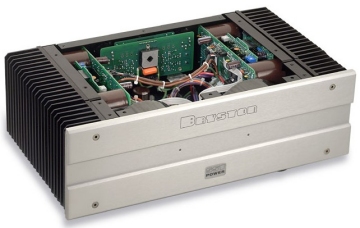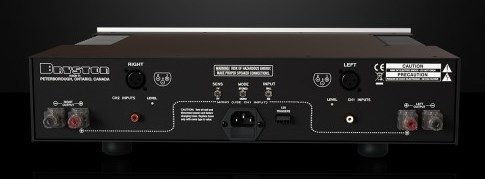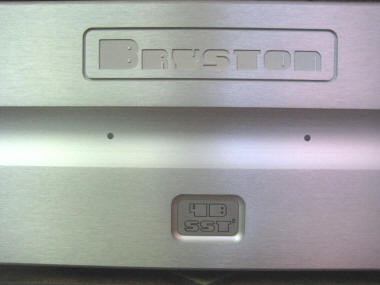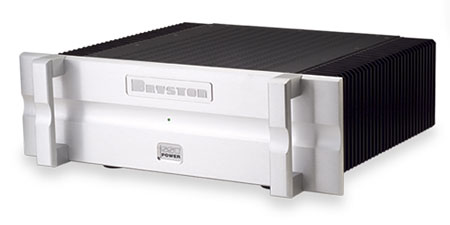The 10Audio review of the Bryston 3B SST, which appeared in July, 2003, concluded with the statement, “The 3B SST is a very listenable amplifier with no significant faults, tremendous drive and cohesion to the real message of the music, all in a very easy-to-live-with package at a bargain price.” A couple of sonic issues were noted, including “…a reduction in low level, high frequency detail and “air”, and a similar reduction in the depth of the sound stage.” I am pleased to report that these relative shortcomings have been addressed in the new “squared” version of the 150 watt per channel Bryston 3B SST2.
This review covers a ten month period during which the 3B SST2 came and went. The 7B SST2s arrived about 4 months later. A 4B SST2 arrived about 2 months after that and a direct comparison of the mono 7B SST2 and the stereo 4B SST2 was possible. The prices are: 3B SST2 – $3850; 4B SST2 – $4550; 7B SST2 – $9190 per pair. Other components on hand during the review included YG Acoustics Kipod Main Modules speakers augmented with a pair of Velodyne Optimum-12 subwoofers, Gallo Strada speakers and TC-3 subwoofer; Mark Levinson 380S and 326S preamplifiers, Krell KCT, ARC LS26, Bel Canto Pre3 and McIntosh C220 preamplifiers; Manley Snapper, Jones Audio PA-M300, Pass x250.5, Parasound JC-1, Krell FPB-300cx and Marantz MA-9S2 power amplifiers; Weiss DAC2 and Prism Orpheus Digital Interface, both used with a custom Windows 7 music computer. Power conditioning includes an Audience aR2p-TO for the amplifiers and PS Audio AV-5000 for all the front-end components, with Jerry’s DIY, Audience PowerChord e and PS Audio AC-12 power cables. Interconnect and speaker cabling is by Mogami.
The correct model designations are 3B SST2, 4B SST2, and 7B SST2. I have changed the superscript to regular text for better paragraph line spacing.

I enjoyed my time with the 3B SST2, starting with removing it from its shipping carton. At only 40 pounds, the amplifier was not harmful to my back as it was moved into place. Compared to the Krell amp, the 3B practically floated on an anti-gravity device. In another contrast to the Krell which has dangerous, razor sharp heat sinks, the Bryston’s heat sinks are nicely finished. If I lifted the Krell from the sides as I did the 3B, the dripping blood from my shredded hands would certainly void Krell’s warranty. The rear settings, common to all three Bryston models, made it very easy to select a balanced or RCA input, mono or stereo operation (for the 3B and 4B), gain and remote trigger options to accommodate any associated preamplifier. Break in is not too critical. All of the models sound good when fresh and new, and break in is mostly complete after 50-75 hours. There are small improvements, mostly in the upper treble, over the next 50-100 hours.
The 3B SST2 offers very good dynamic ability and possibly a more consistent tonal balance than its predecessor. The drum hits in Sting’s “Little Wing” from the Nothing Like the Sun LP, were entirely reproduced. It was easy to hear the drum head recovering to its initial position just milliseconds after the initial impulse. The bass was powerful and controlled, just as in the 3B SST, although it did not give the impression of being especially noteworthy. This is actually good. Anything that stands out and draws attention to itself is invariably a character trait that will be a problem later. The bass was indeed powerful and detailed, but only as required by the music. I did not have the original 3B SST still on hand since the review 7 years ago, but it seemed that the quality of the bass was more consistent with the lower midrange and thus better balanced and less obvious. Nice improvement!
The upper midrange can sound just a small bit forward, with a very small sense of dryness that occasionally draws the listener’s attention to the range of 800-1500 Hz. This is very recording-dependent. However, when I put down the notepad and just listened to music, I found the amplifier very involving and enjoyable. The 3B SST2 does not have the extreme purity in the upper frequencies of the $20,000 Jones Audio mono amps, but then it only costs $16,000 less. Install in a system that that favors harmonic neutrality over audio theatrics and the difference could shrink to a surprisingly small degree.

Despite this small anomaly, there is excellent clarity and resolution in the entire upper frequency range, and better than I remember from the older version. Cymbals stay locked in place on the virtual sound stage with no wandering forward at higher frequencies or different volumes. This is proof of correct tonal balance! The saxophone on Pink Floyd’s “Shine On You Crazy Diamond” on the Wish You Were Here LP is surprisingly present and realistic in my room. On the same album, voices on “Wish You Were Here” seem to come from a point 18 inches to the right and 2 feet behind the right speaker. The voices do not wander and their locations are unambiguous. The sound stage is presented very well without artificially sharp edged outlines of performers. This might seem like a negative, but in live concerts, the sounds of instruments emanate from a small area, not from a tiny 1-dimensional point in space.
Over the last couple of years I have been listening at lower volume levels than I did in the past. I still enjoy “cranking it” and feeling the music through the floor and listening seat, but there is a happy medium that provides the mechanical motion while also being better for the long term health of my hearing. In the hopes of maintaining my hearing acuity as long as possible, I turn down the volume. However, every once in a while, and certainly mandatory for testing audio components for you, I disregard my health and push the limits of the system. At no time during these extreme tests did the front panel LEDs change from their normal green indication to red to indicate clipping. The 150 Watts of rated power was never a limiting factor in my approximately 1500 cubic foot (42.5 cubic meters) listening room.
Overall, the sound of the 3B SST “Squared” is similar to the much more expensive Pass x250.5 amplifier at higher listening levels, but the Bryston’s bass is of higher quality. In fact, the 3B SST2’s bass is as good as or better than anything I have heard in recent memory. If the 3B SST2 was available 10-15 years ago, it probably would have been one of the top 10 amplifiers in the world.

The dual-mono Bryston 4B SST2 sounds very much like its smaller brother. It will play 3 dB louder due to its 300 Watts per channel rating. Actual power, as indicated on the test sheets that accompany every Bryston amplifier, is quite a bit higher. The small hint of dryness that is occasionally noticeable in the upper mids of the 3B is spread over a wider frequency range and is even less noticeable. The instantaneous impact from a drum rim shot is a bit less defined than the presentation from the smaller amp, giving the 4B a more incisive, faster apparent sound. These differences are of a small overall magnitude and should have little or no impact on a buying decision if more than 150 watts per channel are required. After the extended audition of the 4B SST2, I understood why it is Bryston’s most popular model.
Now let’s spend some time talking about the Bryston 7B SST2. The wonderful 7B SST2. Physically compact at 17 inches wide without handles, 6 ¼ inches tall, and about 16 inches deep, the monoblock amplifiers are easy to place on any support. At only 55 pounds each, the weight is manageable, too. The amps can become very warm after prolonged high-volume use, but not too warm to leave a hand resting on the heat sinks for many seconds. In other words, they don’t get hot, unlike the Pass, Krell and Parasound amplifiers. Except for the class-D “digital” amplifiers, including varieties of ICEpower amplifiers which I have not found to offer sound quality that approaches state-of-the-art high-end, the 7B SST2 meets my definition of a “green” component.
Speaking of ICEpower, it has two strengths: the ability to keep complex music nicely sorted out and free from congestion, and effortless dynamics, especially large-scale or “macro” dynamics. The 7B SST2s share these strengths and adds what the digital amps do not provide: exceptional low level resolution, especially in the bass and treble. The Brystons also have excellent clarity of line. Clarity of line is simply the ability to enable the listener to focus on any single instrument or vocalist. A solo instrument is easy to follow, but few amplifiers can differentiate the tones of a French horn and tenor saxophone playing in a full orchestra. Keeping complex music clear and open at any normal volume setting, avoiding congestion and smear, is a mark of a fine amplifier. The 7B SST2s are fine amplifiers.
In some ways, the 7B SST2 is like an adult 3B SST2: more assured, with greater tonal depth and purity – more “wisdom”, bigger, faster, and stronger. The low level resolution is seemingly complete, most welcome in the upper frequencies where a soaring lightness is a match for vacuum tubes. Music has a very real quality with lifelike nuance and texture. Care must be taken to not confuse texture with grain. It would be an easy mistake to attribute previously unheard detail to some measure of grain or distortion that was added by an amplifier. The innate ability of the 7B SST2s to dig very deeply into every instrument and voice is revealed as more hours of listening passes. This provides the perfect excuse to enjoy all my favorite LPs again.
In “Danse Macabre”, on the Witches Brew LP, RCA Victor LSC-2225, the triangle off to the left side of the stage is part of the sound field acoustic. With the Parasound amplifiers, this triangle stands out as a discrete object, separate from the ambiance of the concert stage. Male singers have more in-the-room presence and are more believable than with the other amplifiers on hand during this period, and female vocalists are particularly beguiling.
Early one evening I had an eye strain headache from too much computer time that day. Not the dull throbbing background kind of headache, but the sharp pain behind the eyes kind of headache, the kind that is best treated with closed eyes and quiet surroundings. So I turned on the stereo. After listening to 1 LP side each of The Nylons and the Flying Burrito Brothers, the headache was practically gone. The volume had crept up into the 85dB range, which is not very quiet! “Bryston: Better Than Aspirin!”
How does “fast” sound? When I think of a fast sounding amplifier, it presents the leading edge of a note with unusual precision. “Fast” is a quality that makes me aware of the POP of music – its instantaneous dynamic explosiveness. Sound about right to you? Well, if that is how “fast” sounds, then I am certain that live music is not, ever, fast. Why? Live music does not give the impression that the leading edge of a dynamic impulse exists as a separate musical event. Of course, these beginnings of a sound are not separate events. They are intimately connected to what follows, whether drum hit, pick against a guitar string, or other impulse sound. If the entire note – beginning or leading edge, full tone of the instrument, and the harmonically rich ending of the note – are not produced in full and correct proportion and in the same overall character, then the note will sound artificial.

Too much leading edge without enough of what should follow gives us “fast”. Similarly, too little leading edge with a relative over-abundance of the full note and we say the sound is “slow”, “mellow”, “warm”, etc. I think too many amplifiers fall into the “fast” camp. They surely can POP, but are unable to accurately deliver a lifelike musical event because after the initial impulse, the circuit’s energy may be either depleted or overloaded and the full tone suffers. The 7B SST2s never suffer from this deficiency because even with a startlingly fast and powerful leading edge, the complete tone of the entire note is always fully present.
The soundstage typically extends about 2 feet to the left of left speaker and the same amount to the right of the right speaker. Depth is excellent, offering clearly defined images far back on the stage and through the wall, and occasionally coming right up to my knees. This can be a little scary!
The Bryston amplifiers offer wonderful clarity all across the music spectrum. Present is a level of very low level resolution and texture that is as good as any tube amplifier I have heard. This resolution extends far into the noise floor, which is far below the level of quiet that tubes can achieve. Like good tubes, no trace or hint of grain or grit is ever heard. Nor is there a trace of solid-state hardness: none. If the YG Acoustics Kipods, with their electron microscope-like resolution, don’t broadcast typical solid-state nasties, those nasties are simply not present!
Bryston’s design goal is for the last Watt to sound as good as the first Watt. I did not test this. Actually, it would be more accurate to say that I would not test this, because with well over 600 Watts per channel on tap, the loudness became just too great before I had to back off. There were no discernable changes in the sound quality or character as the loudness increased from quiet to painful levels. I have no idea how the amplifiers would sound at clipping, but it was loud enough as it was to scare the cat and make her hide in a closet. She usually lays on my feet, which is really nice in the wintertime.
This “last Watt sounding as good as the first Watt” stands in stark contrast to the sound from either the $9000 Parasound JC-1 – a competitively priced and targeted product, or the $8250 Pass x250.5. Both amplifiers have a noticeable, harmful change in tonal quality when their output mode of operation changes from class A, which maxes out at 15 Watts from the Pass and 25 Watts from the JC-1s. Their sounds become harder and more forced, less relaxed at higher volume settings. The problem with this is that even with music played softly, many dynamic impulses push these amplifiers’ operation into class AB which sounds noticeably less smooth than their limited pure class A power. So part of the note is class A and often part of the note is not and you hear a dissection of many notes making them sound discontinuous and distorted. The 7B SST2s have a very consistent character at any volume setting, easily matching the purity of the other amplifiers in their class A operation and much more easily surpassing them at higher volume settings.
There are many ways to describe an amplifier’s job: controlling the speakers, amplifying the audio signal, converting electrical energy from the wall into sound energy, etc. Whatever description you choose, one thing an amplifier should not do is draw your attention to its job performance. A good amplifier has great bass, a tactile and human midrange, open and clear high frequencies, and a believable virtual sound stage. A great amplifier lets you forget all that stuff and become immersed in the musical performance, without technological distractions. With the Brystons, it is easy to focus on the deep and resonant bass, the stunningly lifelike vocals, the very natural clarity and ease in the upper frequencies, or look directly at individual performers on a densely populated sound stage. If you want to. It is also very easy to ignore the sound and enjoy the artistic performances, which are compelling. There are no fireworks here, only consistently satisfying sound. The Brystons truly exist in the service of music.
There is a level of performance in audio components that offers a listener a detailed, dynamic, rich, lifelike, powerful presentation that leaves nothing to be desired. The appreciation for this level of performance often takes just a few minutes, but usually fades along with the initial charm of a new component. The 7B SST2’s early attraction has not tarnished over time, and so I purchased them. The 7B SST2s encourage complacency and one finds that thoughts of amplifier comparisons and upgrades are largely absent. There may be better amplifiers, but in the company of an exceptional system, the Bryston amplifiers are as good as they need to be. They consistently deliver, right into your listening room, entirely enjoyable music. Experiencing the amplifiers with very good speakers, such as Gallo Stradas, or the stunningly good YG Acoustics Kipods, the Brystons make it abundantly clear that the amplifiers will probably not be the limiting factor, or weak link, in almost any very high quality music system.
Bryston offers an industry-leading 20 year warranty. This is the first amplifier I have heard that made me pay attention to a warranty. Not because I expect to ever need it – I have never had even the smallest problem with any Bryston amplifier (unlike the Krell and Parasound amps), but because the amplifiers sound so complete, so satisfying even after several months of daily use that it is entirely possible I could keep them for many years. Their exemplary sound quality can easily satisfy over the long haul. The 7B SST2 heralds Bryston’s arrival in the top echelon of today’s amplifier makers.
Overall Ratings:
7B SST2: 10 LPs
3B SST2 and 4B SST2: 9 LPs
Link to Manufacturer’s Web site: Bryston
Thanks to Edward Chung at Viola Audio Video for his kind assistance with the Bryston 3B SST2.
